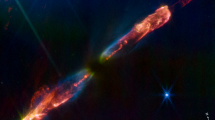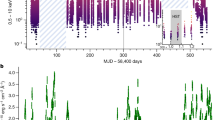Abstract
Stars with masses in the range 1–8 solar masses (M⊙) live ordinary lives for ∼109–1010 years, but die extraordinary deaths. First, during their death throes as asymptotic giant branch (AGB) stars they eject, over 104–105 years, half or more of their mass in slowly expanding, spherical winds, and then, in a short (a few 100–1,000 years) and poorly understood phase, they are transformed into aspherical planetary nebula. Recent studies support the idea that high-speed, jet-like flows play a crucial role in this transformation1. Evidence for such outflows is indirect, however; this phase is so short that few nearby stars are likely to be caught in the act. Here we report the discovery of a newly launched, high-speed jet-like outflow in the nearby AGB star, V Hydrae. We have detected both proper motions and ongoing evolution in the jet. These results support a model in which the jet is driven by an accretion disk around an unseen, compact companion. We also find a central, dense equatorial disk-like structure which may enable and/or enhance the formation of the accretion disk.
This is a preview of subscription content, access via your institution
Access options
Subscribe to this journal
Receive 51 print issues and online access
$199.00 per year
only $3.90 per issue
Buy this article
- Purchase on Springer Link
- Instant access to full article PDF
Prices may be subject to local taxes which are calculated during checkout




Similar content being viewed by others
References
Sahai, R. & Trauger, J. T. Multipolar bubbles and jets in low-excitation planetary nebulae: toward a new understanding of the formation and shaping of planetary nebulae. Astron. J. 116, 1357–1366 (1998)
Kahane, C., Maizels (Barnbaum), C. & Jura, M. The bipolar outflow from the rotating carbon star, V Hydrae. Astrophys. J. 328, L25–L28 (1988)
Sahai, R. & Wannier, P. Discovery of very high velocity outflow in V Hydra—Wind from an accretion disk in a binary? Astron. Astrophys. 201, L9–L12 (1988)
Sugerman, B., Sahai, R. & Hinkle, K. in CO: Twenty-Five Years of Millimeter-Wave Spectroscopy (eds Latter, W. B., Radford, S. J. E., Jewell, P. R., Magnum, J. G. & Bally, J.) 108–111 (IAU Symp. Vol. 170, Kluwer Academic, Dordrecht, 1996)
Kahane, C., Audinos, P., Barnbaum, C. & Morris, M. V Hydrae: the missing link between spherical red giants and bipolar planetary nebulae? Radio observations of the molecular envelope. Astron. Astrophys. 314, 871–882 (1996)
Knapp, G. R., Jorissen, A. & Young, K. A 200 km/sec molecular wind in the carbon star V Hya. Astron. Astrophys. 326, 318–328 (1997)
Lloyd Evans, T. Optical spectroscopy of the jet in V Hydrae. Mon. Not. R. Astron. Soc. 248, 479–482 (1991)
Knapp, G. R. et al. The light curve and evolutionary status of the carbon star V Hya. Astron. Astrophys. 351, 97–102 (1999)
Barnbaum, C., Morris, M. & Kahane, C. Evidence for rapid rotation of the carbon star V Hydrae. Astrophys. J. 450, 862–875 (1995)
Lee, C-F. & Sahai, R. Shaping proto-planetary and young planetary nebulae with collimated fast winds. Astrophys. J. 586, 319–337 (2003)
Lloyd Evans, T. in The Carbon Star Phenomenon (ed. Wing, R. F.) Vol. 177, 367–376 (IAU Symp., Kluwer, Dordrecht, 2000)
Hartigan, P., Raymond, J. & Hartmann, L. Radiative bow shock models of Herbig-Haro objects. Astrophys. J. 316, 323–348 (1987)
Livio, M. in Accretion Phenomena and Related Outflows (eds Wickramasinghe, D. T., Bicknell, G. V. & Ferrario, L.) 845–860 (ASP Conf. Ser. 121, IAU Colloq. 163, Astronomical Society of the Pacific, San Francisco, 1997)
Morris, M. Mechanisms for mass loss from cool stars. Publ. Astron. Soc. Pacif. 99, 1115–1122 (1987)
Soker, N. & Rappaport, S. The formation of very narrow waist bipolar planetary nebulae. Astrophys. J. 538, 241–259 (2000)
Soker, N. Jet formation in the transition from the asymptotic giant branch to planetary nebulae. Astrophys. J. 389, 628–634 (1992)
Alcolea, J., Bujarrabal, V., Sánchez Contreras, C., Neri, R. & Zweigle, J. The highly collimated bipolar outflow of OH 231.8 + 4.2. Astron. Astrophys. 373, 932–949 (2001)
Imai, H., Obara, K., Diamond, P. J., Omodaka, T. & Sasao, T. A. A collimated jet of molecular gas from a star on the asymptotic giant branch. Nature 417, 829–831 (2002)
Kastner, J. H. et al. Compact X-ray source and possible X-ray jets within the planetary nebula Menzel 3. Astrophys. J. 591, L37–L40 (2003)
Kellogg, E., Pedelty, J. A. & Lyon, R. G. The X-ray system R Aquarii: A two-sided jet and central source. Astrophys. J. 563, L151–L155 (2001)
Bally, J. in Accretion Phenomena and Related Outflows (eds Wickramasinghe, D. T., Bicknell, G. V. & Ferrario, L.) 3–13 (ASP Conf. Ser. 121, IAU Colloq. 163, Astronomical Society of the Pacific, San Francisco, 1997)
Reipurth, B., Heathcote, S., Morse, J., Hartigan, P. & Bally, J. Hubble Space Telescope images of the HH 34 jet and bow shock: Structure and proper motions. Astron. J. 123, 362–381 (2002)
Soker, N. Pairs of bubbles in planetary nebulae and clusters of galaxies. Publ. Astron. Soc. Pacif. 115, 1296–1300 (2003)
Acknowledgements
We thank H. Imai for commenting on an earlier version of this paper. We are grateful to NASA for partial financial support, obtained through: the Long Term Space Astrophysics programme for R.S. and M.M.; and grants for R.S. from the Space Telescope Science Institute, which is operated by the Association of Universities for Research in Astronomy, Inc., under a NASA contract.
Author information
Authors and Affiliations
Corresponding author
Ethics declarations
Competing interests
The authors declare that they have no competing financial interests.
Rights and permissions
About this article
Cite this article
Sahai, R., Morris, M., Knapp, G. et al. A collimated, high-speed outflow from the dying star V Hydrae. Nature 426, 261–264 (2003). https://doi.org/10.1038/nature02086
Received:
Accepted:
Issue Date:
DOI: https://doi.org/10.1038/nature02086
This article is cited by
-
Carbon stars
Journal of Astrophysics and Astronomy (2010)
-
Planetary nebulae NGC 6826 and NGC 2899: early aspherical mass loss?
Astrophysics and Space Science (2009)
-
The study of evolved stars with ALMA
Astrophysics and Space Science (2008)
-
The mystery companion
Nature (2003)
Comments
By submitting a comment you agree to abide by our Terms and Community Guidelines. If you find something abusive or that does not comply with our terms or guidelines please flag it as inappropriate.



